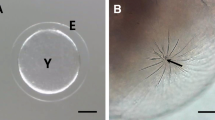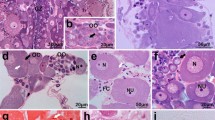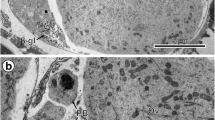Summary
This communication presents results of studies on the formation and structure of the vitelline envelopes in three species of mites: Euryparasitus emarginatus (Gamasida), Erythraeus phalangoides (Actinedida), and Hafenrefferia gilvipes (Oribatida). In E. emarginatus and E. phalangoides, in which the oocytes are not covered with follicular cells, the material of the vitelline envelope appears first in vesicles under the surface of the oocytes prior to secretion by exocytosis. The formed vitelline envelope is built of a homogeneous material which is perforated by numerous channels containing oocyte microvilli. Later, as the microvilli are retracted, the channels disappear. In both of these species the formed vitelline envelope is incomplete and the micropylar orifice occurs as a transitional structure.
In H. gilvipes follicular cells encircling the oocyte contain granules filled with material that is subsequently secreted into the perivitelline space forming the vitelline envelope on the oocyte surface. The inner layer of the vitelline envelope is granular, whereas the outer part is more homogeneous. Both lack channels containing microvilli and micropyle.
Similar content being viewed by others
References
Anderson E (1974) Comparative aspects of the ultrastructure of the female gamete. Int Rev Cytol Suppl 4:1–70
Biemont JC, Chauvin G, Hamon C (1981) Ultrastructure and resistance to water loss in eggs of Acanthoscelides obtectus Say (Coleoptera: Bruchidae). J Insect Physiol 27:667–679
Brinton LP, Oliver JH (1971) Fine structure of oogonial and oocyte development in Dermacentor andersoni Stiles (Acari: Ixodidae). J Parasitol 57:720–747
Chauvin G, Barbier R (1979) Morphogenèse de l'enveloppe vitelline, ultrastructure du chorion et de la cuticule sérosale chez Korscheltellus lupulinus L. (Lepidoptera: Hepialidae). Int J Insect Morphol Embryol 8:375–386
Diehl PA, Aeschlimann A (1982) Tick reproduction: oogenesis and oviposition. In: Obenchain FD, Galun R (eds) Physiology of ticks. Pergamon Press, New York, pp 277–350
Dumont JN, Anderson E (1967) Vitellogenesis in the horseshoe crab, Limulus polyphemus. J Microsc 6:791–806
Ludwig H (1874) Über die Eibildung im Tierreiche. Arb Physiol Lab Würtzburg 1:287–510
Nuzzaci G, Liaci LS (1975) Aspetti ultrastrutturali della cellula uovo e delle cellule follicolari di Phytoptus avellanae Nal. (Acarina: Eriophyoidea). Entomologica 11:173–181
Ōsaki H (1971) Electron microscope studies on the oocyte differentiation and vitellogenesis in the liphistiid spider, Heptathela kimurai. Ann Zool Jpn 44:185–209
Ōsaki H (1972) Electron microscope studies on developing oocytes of the spider, Plexippus paykulli. Ann Zool Jpn 45:187–200
Reger JF (1977) A fine structure study on vitelline envelope formation in the mite, Caloglyphus anomalus. J Submicr Cytol 9:115–125
Richardson KC, Jarret LJ, Finke EH (1960) Embedding in epoxy resins for ultrathin sectioning in electron microscopy. Stain Technol 35:313–323
Witaliński W, Żuwala K (1981) Ultrastructural studies of egg envelopes in harvestmen (Chelicerata, Opiliones). Int J Invert Reprod 4:95–106
Witte H (1975) Funktionsanatomie des weiblichen Genitaltraktes und Oogenese bei Erythraeiden (Acari, Trombidiformes). Zool Beiträge 21:247–277
Woodring JP, Cook EF (1962) The internal anatomy, reproductive physiology, and molting process of Ceratozetes cisalpinus (Acarina: Oribatei). Ann Entomol Soc Amer 55:164–181
Author information
Authors and Affiliations
Rights and permissions
About this article
Cite this article
Witaliński, W. Egg-shells in mites. Cell Tissue Res. 244, 209–214 (1986). https://doi.org/10.1007/BF00218401
Accepted:
Issue Date:
DOI: https://doi.org/10.1007/BF00218401




